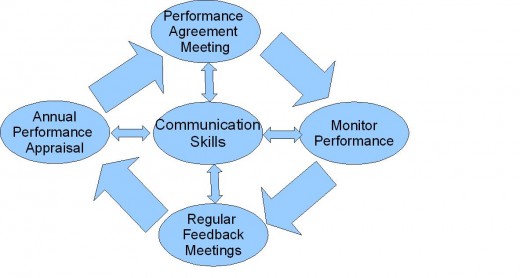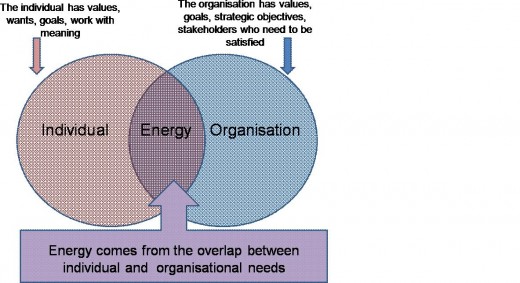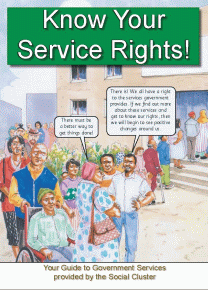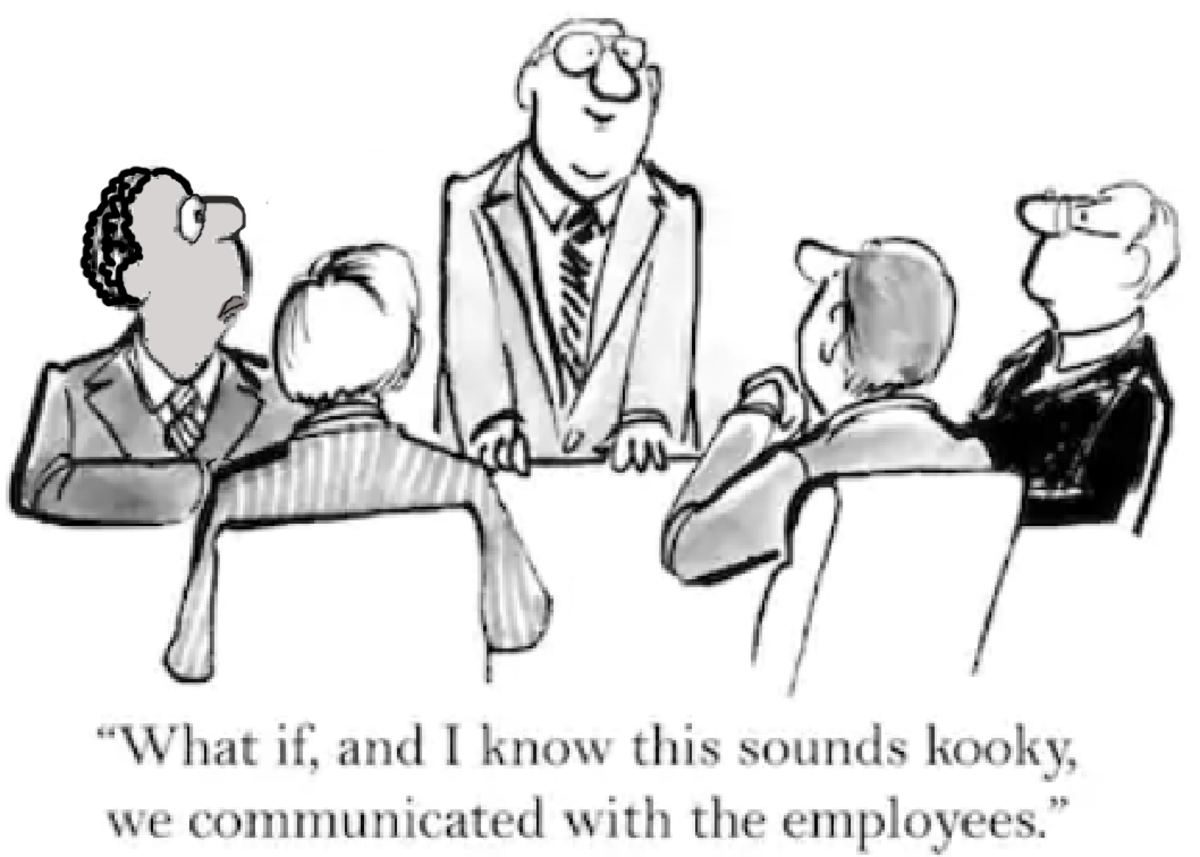How to create a Performance-Driven Work Environment in a successful organisation with effective communication
Service in South Africa
Who has never experienced bad service? We have all had the experience of not getting what we expected from a service situation, whether in a retail store, a restaurant, a public service office or even the local health professionals office.
In the normal run of things this is just irritating, and we very often respond by simply taking our custom elsewhere.
In a country such as South Africa, however, poor service can be a lot more than just irritating. It can be something that threatens even the stability of the society in which we live.
The reason for this is that South Africa is a hugely unequal society in which the gap between those who have and those who don’t, already very wide, is becoming wider by the day.
The Gini co-efficient, which indicates statistically the gap between any two variables, is often used to rate the level of inequality in a society, or at least the perception of that inequality. The co-efficient is a scale from 0 to 1, where 0 represents a totally equal society and 1 a totally unequal society. At present South Africa’s Gini co-efficient is hovering about 0.7, in other words, on the high side, indicating a very unequal spread of the good things in life between those who have them, mainly white, and those who don’t, mainly Black people.
This is mainly a result of the deliberate separation of races and consequent unequal division of resources in the country which was the social engineering of apartheid. This is in spite of the ruling party winning resounding mandates in the past four general elections based on the slogan “A better life for all.”

- http://www.news24.com/Content/SouthAfrica/News/1059/0fa37feb455b49b68f608285cbc7b38d/08-06-2009%2009
“About 5 000 people showed up over (poor) service delivery and soon became violent. The police shot at them with rubber bullets since they were obstructing roads, burning vehicle tyres and throwing rocks at passing cars and buses,” said Khoabane. - March against poor delivery: News24: SouthAfrica: News
March against poor delivery: News24: SouthAfrica: News. Residents in several parts of Gauteng will protest against poor service delivery in their areas, the Anti Privatisation Forum says.
Like a match to dry tinder
So far, after 15 years of a non-racial, non-sexist democratic dispensation, although in absolute terms things have improved, there is still the perception, as shown by the Gini co-efficient, of gross inequality still reflecting the old lines of division.
In such a situation poor service can be like a match to dry tinder. Indeed we see daily evidence of the anger and disillusionment of the majority of South Africans who feel they are still being given the short end of the social and economic stick.
So whereas service in an organisational sense is a factor in the survival of the organisation, in the social sense service delivery is critical for the ongoing stability and well-being of the whole of society.
What we need to grasp as a country is that we cannot afford to provide poor service any longer, because we are gong down a path that will lead to massive social unrest if the trend is not reversed, if the people don’t soon get to feel that their needs are being addressed in a meaningful way, in way that they can feel the difference. We need as a country to reverse the trend of the worsening Gini co-efficient and get it moving in the other direction, the direction of a more equitable distribution of resources and the access to resources and services of quality.
It is my view that the situation is a management problem, a problem of the managerial will to put into effect the many excellent policies that have been put in place by the Government over the past 15 years. If these policies were put into place effectively, with a sense of urgency, the negative trend of the Gini could be reversed and turned into a positive trend.
So what to do about this problem?
What drives service?
Service is driven by passion, by a commitment to deliver, to make a difference. In the private sector the drive is usually one of profit, but in the public sector profit is not a driver, so other things have to be found to harness people’s energy and give it the direction needed to produce superior service delivery.
As I said, it is a management problem, a problem of productivity and the particular way in which productivity can be envisaged in the public service. An effective model for this is the service chain leading to the moment of truth, the moment of the delivery of service to the recipient of that service, the person who needs the service.

The chain of service
To understand the chain of service it is helpful to use the model I call the basic systems theory model. This model shows how inputs are processed to produce outputs. An important factor to bear in mind is that every output becomes an input into someone else’s process, thus creating a chain of service.
A very simple graphic illustration of the basic systems theory model shows how these three aspect fit together. Management’s task is to ensure process improvement, the increasingly efficient use of resources to achieve an optimal productivity ratio. Productivity is expressed as the ratio of Output over Input, which should, if the process is productive, be greater than 1. Or put slightly differently, the value of the output of the process must always be greater than the value of the inputs used in the process. If this is not the case, then the process should be questioned, the inputs reduced or the outputs increased with no increase in process costs.
This is in fact is one goal of performance management, to maximise the efficiency of all processes under management.
As alluded to above, all outputs are designed to be inputs into the next process. Another way to express this is to say that every organisation exists to service needs, and for the organisation to be effective it has to have a full understanding of the needs it seeks to service. Without a constant examination of the needs of the end users the organisation runs the risk of producing something that no-one in effect needs. In that case the output is shear waste and the inputs have been used to no good purpose; in other words, in the parlance of the Public Finance Management Act, those inputs represent “fruitless and wasteful expenditure.”
So another goal of performance management is to ensure the effectiveness of all processes under management, to ensure that the outputs are indeed what the end user needs or wants.
This point is important enough to bear repeating: Every organisation exists to service needs, and if it does not the organisation will become extinct because there is then no justification for its continued existence.
Optimising service is the overall goal of performance management.
The organisation needs to organise itself appropriately the achieve this. This will be in terms of the organisation’s strategy, structure, staff and the policies and procedures set up to make it all happen.
As Tom and Birgit Hanson write in their excellent little book Who Will Do What by When: “Your personal reputation and the success of your organisation depend on your ability to make and fulfill promises.” Every manager in an organisation must have as a goal to increase their own and their people’s ability to make and keep promises.
How well they do this is determined mainly by the quality of the relationships they have with their people. To quote the Hansons again: “The most important variable in determining the performance and retention of top employees is their relationship with their primary supervisor.”
So all the processes, policies and procedures in the organisation should be geared to support and enhance these relationships. And performance management is essentially the development of this relationship. Without a quality relationship between manager and direct reports at all levels in the organisation, there will be no quality of service.
This is well captured by Stephen R. Covey in The Seven Habits of Highly Effective People:“Always treat your employees exactly as you want them to treat your best customers.” This is the first principle of performance management.
Performance management is essentially people management, and if a manager is not managing the performance of his or her people, then it can reasonably be asked what they are actually managing.
People Management
Management is a relationship-building role. The relationship that matters most, as we have seen above, is the one between managers and their direct reports.
This relationship must always be one in which the “first principle” of performance management is upheld, i.e. the manager must at all times treat employees as she/he would want them to treat the organisation’s best customer. This is not negotiable, it is the most important principle that a manager should adhere to.
How to make this happen
Relationships between people are built primarily by them communicating with each other. And so the quality of the interpersonal communication between them becomes of paramount importance in creating a performance-driven culture within the organisation.
It is also important to recognise that this communication does not take place in a vacuum, it is not separate from all the communication going on in an organisation.
So the organisation’s leadership and management need to take a holistic view of communication, to see communication in its totality in the organisation.
This means that in order to create a performance-driven culture in an organisation a holistic communication strategy is needed, one which will guide all the communication of the organisation, internal and external, verbal and written.
In developing such a strategy it is important that the difference between transmission of a message and communication is understood. That is, two-way communication is more effective, especially in driving performance, than one-way communication.
In general,. all communication within or external to the organisation should reflect the organisation’s values. In doing so it is vitally important that there is no gap between the stated values and the real values – in other words, it is vitally important that all people at all levels, walk the talk, that the values do not remain sterile statements designed to look good in organisational publications and on boardroom walls, but are statements of the reality within the organisation. A gap between stated and real values, breeds cynicism and distrust where enthusiasm and trust are needed.
For example, if a corporate advertisement states that the organisation is committed to quality in all it does, but the employees know that in fact management has ordered serious corner-cutting to maximise margins, employees will be placed in an unacceptable double bind – wanting to support their organisation but not wanting to misrepresent the truth they will be effectively disempowered.
Similarly in the internal communications of the organisation more should be attention paid to the concerns of the targets of the communication than to management’s concerns.
It is important that all communications strengthen the primary management relationship – that between manager and direct reports.
- Customer Service Skills
Customer service skills are a key when working in any field and generate return customers, trust, and a solid reputation for both you and your employer. This has become a crucial aspect to the survival of any... - Good Customer Service: The Key to a Profitable Business
It is not unusual for many business establishments to spend more time and effort on attracting new consumers than they are on retaining the customers they have. They do not understand that keeping your loyal... - Need and importance of training employees in your organisation
Training your employees do have a significant role in modern business era. Not just to equip them with latest tools your company has implemented, there is a lot more to it.I have sorted down them in a list.... - Organizational Behavior: Terminology and Concepts
Schermerhorn et al (2005), define organizational behavior (OB) as "the study of human behavior in organizations" (p. 3). OB uses scientific methods to test hypotheses. OB is also a multi-disciplinary study,...
Facilitate communication
Leaders and managers have a responsibility to facilitate communication throughout the organisation. To help us understand this it is helpful to look at communication modes and opportunities.
Internal communication comprises three primary modes: verbal, written and the more one-on-one of inter-personal communication.
All internal communications should constantly promote the organisation’s values, especially the value of people.
The objectives of internal communication are:
To promote cohesion by emphasising employee interests not management values; convey information, specifically what employees need to know;
To facilitate change – the fear of change can be reduced by keeping employees informed
Values - the organisation’s values need to be understood and committed to by all. There should be no gap between stated and real values
External communication comprises all the advertising and public relations types of communication and these should be seen in the context of a comprehensive communications strategy.
Performance management is essentially an inter-personal communication process in which, if it is to be effective, three basic psychological needs of the people involved need to be met.
These psychological needs are:
a. the need for respect, to be treated with dignity as an individual;
b. the need for understanding, to feel understood as a human being with feelings and aspirations; and,
c. the need for involvement, to feel part of something, to have a contribution to make.
Each of these needs is met by a specific communication skill of which, as Covey has said: “The ability to do them well is critical to your effectiveness.”
To show respect means to maintain or enhance the self-esteem of the other person, not to do anything that might lower their self-esteem. This in turn means to look for something in the person’s performance that can honestly be praised. Always notice and comment on positive performance because commenting only on the negative tends to encourage poor performance.
The 5th Habit in Covey’s model of the highly effective person is “Seek first to understand, then to be understood.” This is the skill which addresses the second psychological need of understanding. The quality of being that is required here is that of empathy, the ability to place oneself, without judgement, in the other person’s frame of reference, to see things from their point of view. In Covey’s words, “You have to build the skills of empathic listening on a base of character that inspires openness and trust.”
The need for involvement implicates the principle of synergy – creative co-operation. This means not imposing solutions on people but on collaboratively looking for solutions and valuing the differences between people. Differences can be sources of strength when the focus is on finding the “win/win” solution. Having found such a solution to whatever the problem is, the manager then provides support without taking away responsibility.

A Performance Management Cycle
A simple performance management cycle is illustrated below. It starts with the performance agreement meeting in line with Covey’s habit: “Begin with the end in mind.”
In this meeting the manager and his or her report will agree on the purpose of the job in line with the organisational vision/mission. In the course of their discussion they will agree the standards and milestones that will be measured in the performance period.
This is what Covey terms a “Win/win performance agreement” in which the participants agree results, the manager undertakes to provide appropriate support and otherwise to get out of the way of the employee. They also agree to have regular performance-based discussions, the timing of which will be based on the employee’s needs and the complexity of the tasks.
Such performance agreements are based on trust, which is the basis for performance. How the manager and employee communicate can either develop or destroy trust.
The next phase is to monitor performance against the agreed standards or milestones. If the performance of the employee is falling below the agreed standards, the manager needs to provide feedback non-defensively, focusing on the problem and on how to get the performance back up to standard, rather than attacking or blaming the employee for the lack of performance. It’s a problem to be solved not punished and represents a learning opportunity for both.
It is critically important also to acknowledge achievement of agreed results.
Trust, just like muscle, is built over time.
As the Hansons wrote: “The words themselves are not magical: how you say something creates the context for the communication.”
The potential of effective communication
If the total communication effort in the organisation is congruent and serves to strengthen the primary relationship between employee and direct supervisor, keeping the organisation’s vision and mission in focus, the result will be a performance-driven culture.
In such a culture everyone will be focussed on appropriate service delivery, and this focus is achieved and maintained by effective communication


A performance-driven culture
In a performance-driven culture the overlap between individual values, wants, goals and the desire for work with meaning and the organisation’s values, goals, strategic objectives and the satisfaction of stakeholders will be great. It is from this overlap, as illustrated below, that the energy, commitment drive and passion for service will come. The overlap is achieved by effective communication in a developmental performance management system which emphasises communication and the development of trust before measurement.
Too often performance management is seen by management as an exercise in measurement and so elaborate measurement tools and systems are put in place without doing anything to engage the employees and build their trust. Measurement becomes the objective instead of performance, and this can lead, as it very often does, especially in the Public Service, to manipulation of the measurement system instead of focusing on the development of the people.
Performance management then becomes just another activity that managers and employees, rather unwillingly, have to perform in order to get HR off their backs. Then the natural desire of people to contribute, to create and to make a difference is smothered in red tape and piles of unfriendly and complicated forms. Filling in the forms becomes the thing.
I am not suggesting for one moment that measurement is not important. It is vitally important, but if it is done in a context of little or no trust, if the people in the organisation are not committed to achieving the organisation’s strategic goals, then measurement will be seen as threatening, as something to be manipulated and service delivery will take second place to compliance.
It is my view that this way of looking at performance management in the Public Sector has led to exactly this situation and this is the reason for the problems South Africa faces with regard to service delivery, why there are tyres burning in the streets and people are showing many signs of anger and disillusionment.
Economist Iraj Abedian, writing in the Mail and Guardian of 19 June 2009 highlighted exactly this problem: “… blatant condoning of poor performance and suboptimal use of public resources has a strong systemic and corruptive impact on the operational efficiency of the public sector..”
The Public Service has a programme designed to improve service delivery called “Batho Pele”, which means “People First.” Its time Public Service manager put it into practice this value and treated their employees as they would have their employees treat the very valuable public of South Africa, a public which is in dire need of service delivery of a high standard.

For further reading
Covey, Stephen R: The Seven Habits of Highly Effective People London: Simon & Schuster 1992
Hanson, Tom & Hanson, Birgit: Who Will Do What by When? Power Publications 2007
Keavney, Jack: Peak Performance Sydney: McGraw-Hill 1996
Kohn, Stephen E. & O’Connell: 6 Habits of Highly Effective Bosses Fanklin Lakes NJ: Career Press 2005
Copyright Notice
The text and all images on this page, unless otherwise indicated, are by Tony McGregor who hereby asserts his copyright on the material. Should you wish to use any of the text or images feel free to do so with proper attribution and, if possible, a link back to this page. Thank you.
© Tony McGregor 2009










